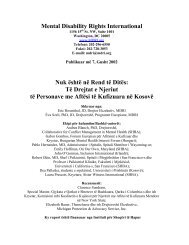Torture not Treatment - Disability Rights International
Torture not Treatment - Disability Rights International
Torture not Treatment - Disability Rights International
You also want an ePaper? Increase the reach of your titles
YUMPU automatically turns print PDFs into web optimized ePapers that Google loves.
TORTURE NOT TREATMENT<br />
The implication of this approach is a highly unorthodox program for treatment and education.<br />
All residents, regardless of diagnosis or history, are subjected to the same behavior modification<br />
techniques of reward and punishment. The use of traditional psychological therapies and/or<br />
medication is virtually non-existent at JRC. 9 Psychotropic medications are rarely used. 10<br />
According to JRC, seventy percent of educational instruction in the school consists of solitary<br />
work on a computer referred to by JRC as ―self-paced, programmed instruction.‖ 11<br />
The ―rewards‖ used at JRC include ―a contract store‖ where students can ―pick rewards to<br />
purchase‖ based on points they earn in the program. Rewards also include such basics as the<br />
right to social interaction with other patients or staff, 12 as well as other fundamentals of daily<br />
living. For example:<br />
By making our school building as rewarding as possible, both in its look and in its<br />
various reward functions and areas, we have been able to use the opportunity to attend the<br />
school building as an earned reward. Similarly, students who behavior extremely poorly<br />
are required to stay in their residence and receive academic instruction there, instead of at<br />
our school building. 13<br />
One of the implications of the behaviorist model of care is that JRC takes anyone so long as<br />
―needed treatment procedures are made available to us.‖ 14 As the JRC website states, ―Our<br />
policy of near-zero reject and expulsions, coupled with the success we demonstrated in treating<br />
our students, resulted in agencies referring their most difficult behavior problems to us. Most of<br />
our referrals had been unsuccessfully served in numerous other private and public mental health<br />
and educational facilities before they were referred to JRC.‖ 15<br />
The ―near-zero rejection‖ policy has allowed the facility to become what JRC calls a ―hospital of<br />
the last resort‖ 16 for children or adults with disabilities who simply have nowhere else to go. The<br />
fact that JRC is the last stop for parents looking for a placement for their child may explain the<br />
fervent support for the program that some parents have expressed over the years. In other cases,<br />
however, JRC actively markets its programs by visiting families and giving them brochures and<br />
gifts to recruit new students. 17<br />
When I visited the place, I was expecting much more difficult, non-communicative<br />
behavior in these children. It was a total surprise to me to find out that half to two<br />
thirds of the kids from NY had learning disabilities or emotional problems – street kids,<br />
kids of color – carrying these shock backpacks. It is prison-like and they are prisoners<br />
of the apparatus.– Psychologist who visited JRC on behalf of the New York State<br />
Department of Education 18<br />
In the early days of the facility, most students were diagnosed with autism or mental retardation<br />
and accompanying self-injurious behaviors. As of 2006, however, according to a New York<br />
State Department of Education (NYSED) report, most students from New York State ―have the<br />
7




